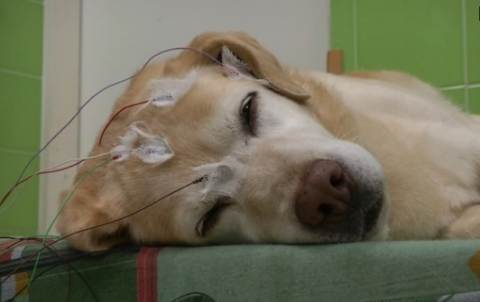
BUDAPEST, Hungary (Reuters) — Scientists in Hungary say they have measured brain activity in dogs which shows they learn during their sleep.
The Senior Family Dog Research team at the Ethology Department of Budapest’s ELTE university conducted electroencephalograms (EEGs) on sleeping dogs, using electrodes placed on the head to record electrical activity in the brain.
Fifteen family dogs were taught commands in English instead of Hungarian, before being left to sleep in a darkened room for three hours.
Neuroscience researcher Ivaylo Iotchev said the EEGs showed very brief bursts of brain activity called sleep spindles.
“From studies with humans and rodents we know that they are extremely useful markers both of memory and cognition but also of ageing and activity,” Iotchev told Reuters.
He added that the research for the first time linked sleep spindles and brain function in dogs.
“This is the first time we were able to show that sleep spindles predict learning in the dog,” Iotchev said.
The study is part of a broader research framework aiming to understand how dogs’ cognitive ability and memory changes with age. Funded by the European Research Council, the interdisciplinary research combines behavioural, neuroscientific and genetic testing methods.
Researchers hope the results will not only help with the understanding of ageing in dogs and the development of therapies to improve welfare, but also aid understanding of the biological background of human cognitive ageing.
Almost one third of 11 to 12-year-old dogs and 70% of 15 to 16-year-old dogs show cognitive disturbances corresponding to human senile dementia, the researchers say. These include spatial disorientation, social behavior disorders, apathy, increased irritability, sleep-wake cycle disruption, incontinence, and reduced ability to accomplish tasks.
The researchers also use functional magnetic resonance imaging (fMRI) tests to identify neural correlates which are associated with cognitive ageing.
“This dementia is really very similar in a lot of aspects to that of humans, so we could use dogs as a natural model of human ageing,” senior researcher Eniko Kubinyi told Reuters.
The department has established a Dog Brain and Tissue bank in order to share samples of neurodegenerative diseases and ageing with researchers worldwide.








